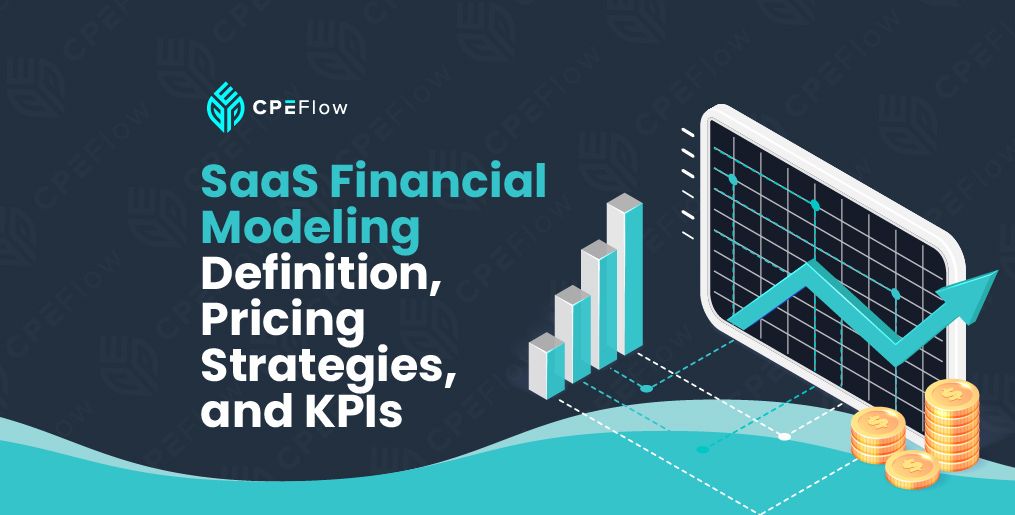Imagine trying to build a house without any structural or design blueprints. Yes, you might have the right materials and a strong vision. However, without a solid plan, the final result is anyone's guess.
Likewise, financial modeling serves as a blueprint that helps companies plan, forecast, and make informed decisions based on historical data. It also provides investors and stakeholders with greater clarity to assess the performance and potential growth of a specific business. Without it, companies take shots in the dark with each decision they make and risk missteps and missed opportunities.
If you're running or working in a software-as-a-service (SaaS) company, it's essential to have financial modeling in your arsenal of tools. SaaS companies tend to rely on recurring revenue and customer retention. Thus, it's no surprise that their financial records tend to be more complex and distinct from those of traditional businesses.
In this article, we'll break down the basics of SaaS financial modeling. We'll cover what it is, how different revenue models work, key financial statements, and the essential metrics every SaaS company should track.
Looking to sharpen your SaaS financial modeling skills? Check out
CPE Flow's SaaS Financial Modeling course, which is designed to help you build models from scratch and confidently interpret their results.
A software-as-a-service (SaaS) company delivers software applications online, so customers won't have to download and install the application on their devices. These cloud-based applications can be accessed anytime and from anywhere, as long as an internet connection is available. They also allow for automatic updates, which can be rolled out to all users simultaneously.
SaaS companies usually operate on a subscription-based model. Rather than a one-time purchase, customers will instead pay a recurring fee to access and utilize the platform.
These companies offer a wide range of features and help clients solve various problems. Some focus on e-commerce or customer relationship management, while others provide entertainment, productivity tools, or industry-specific solutions.
A SaaS financial model provides a detailed breakdown of a company's current financial health and projected future performance.
These models are typically built using historical data and a set of assumptions about the future. Unlike traditional businesses, which often rely on one-time purchases, SaaS companies generate revenue through recurring subscriptions. This makes it especially important to monitor key metrics, some of which include customer acquisition cost, retention, and churn rates.
That's why financial modeling is a must-have in every SaaS company's strategic toolbox. It helps them understand their growth potential, manage cash flow effectively, and make informed decisions about pricing strategies, investments, and operational expenses.
Get Exclusive Access & Special Discounts!
Get early bird access to new CPE courses and exclusive discounts only shared with our email subscribers.
Revenue modeling is a crucial component of financial modeling for SaaS companies.
Since most SaaS business models rely on recurring revenue, understanding how different pricing strategies translate into revenue is key to building accurate forecasts and making better-informed decisions.
Let's explore the different SaaS pricing models.
Tiered pricing is one of the most widely used revenue models in the SaaS industry. Companies offer different packages or "tiers" at various price points. Each has its own set of features and usage limitations.
With this structure in place, customers will be able to choose a plan that best suits their needs and budget.
Flat-rate pricing offers a single fixed price for access to a single product, typically with a fixed set of features. The upside is that it makes it simple for customers to understand what they're paying for, and this can reduce friction during the sales process.
But the downside is that it lacks flexibility for scaling revenue from customers who love the product and may be willing to pay more for additional value or usage.
With the per-user pricing model, customers are charged based on the number of users that have access to the software.
This model is popular for SaaS products that cater to companies with multiple employees using the platform. However, it can discourage adoption, as some companies may limit the number of users to avoid higher costs.
SaaS financial statements are a set of records that allow you to track and dive deeper into a company's financial health, sustainability, and performance over time. They provide a structured snapshot of how the business earns and spends money.
Some examples of financial statements that a SaaS company would utilize include the following:
- Income Statement (Profit & Loss Statement): This financial document outlines your company's profits and losses over a specific period. SaaS companies often use accrual-based accounting, which is generally preferred over cash-based accounting. Under accrual accounting, income and expenses are recorded when they are earned or incurred, regardless of whether the money has actually exchanged hands. Key components of a SaaS income statement include recurring revenue, customer acquisition costs (CAC), operating expenses, and gross margins.
- Balance Sheet: The balance sheet illustrates a company's financial position at any specific point in time. All its assets, liabilities, and equities are listed. This financial statement helps stakeholders understand how much cash the company has, how much it owes, and how it's funding its growth.
- Cash Flow Statement: Essentially, this statement summarizes the flow of cash into and out of your SaaS company. A company's cash flow is typically split into operating, investing, and financing activities. This financial statement can provide insights into how profitable and sustainable your SaaS company is.
These three core financial statements enable leaders, investors, and stakeholders of SaaS companies to keep tabs on the company's performance, make informed decisions, and plan strategically for future growth.
A significant part of financial modeling involves tracking and interpreting key metrics related to your company's performance.
Here are some examples of the most important KPIs for SaaS companies:
- Customer Acquisition Cost: CAC is the average cost to acquire a new customer
- Customer Lifetime Value (LTV): LTV represents the total revenue a company can expect to earn from a single customer over the entire duration of their relationship.
- Churn Rate: This metric represents the percentage of customers who cancel their subscription during a given period. A high churn rate can indicate that your company isn't retaining customers effectively, which can hurt your recurring revenue.
- Annual Recurring Revenue: ARR is the total recurring revenue expected on an annual basis.
- Monthly Recurring Revenue: MRR is similar to ARR, but measured monthly. MRR helps track short-term revenue trends and performance.
- Net Revenue Retention: NRR measures the percentage of existing revenue that is retained over time from existing customers. It accounts for upgrades, downgrades, and customer churn. Based on this, you can get a good idea of your company's ability to sustain or expand its revenue from the current customer base.
Creating a reliable SaaS financial model goes far beyond just plugging numbers into a spreadsheet. To ensure your model is useful and practical, try to keep these best practices in mind:
- Start with clear assumptions: Define your key drivers, such as pricing, customer acquisition, churn rate, and expenses, before building your model. It's also important for you to ensure that each assumption is grounded in realistic benchmarks or historical data.
- Keep it modular and flexible: Break your model into smaller sections, so it's easier to manage and update. This also allows you to effectively spot and correct mistakes.
- Track key SaaS metrics: Embed the necessary core KPIs like CAC, LTV, MRR, and NRR into your model to measure performance over time and support effective reporting.
- Validate the model: Conduct sensitivity analyses to determine the impact of changes in key variables on the outcomes.
- Update regularly: A financial model is only as good as its data. Review and update your assumptions and data frequently to maintain accuracy.
With its heavy reliance on recurring revenue and customer retention, SaaS businesses need clear visibility into their financial health.
Well-structured SaaS accounting practices will empower founders, finance teams, and stakeholders to make informed, data-driven decisions that can fuel the growth and success of their businesses.
If you're looking to strengthen your financial modeling skills, check out
CPE Flow's SaaS Financial Modeling course. You'll learn how to build a complete SaaS financial model from scratch, interpret key metrics, and forecast revenue. All these can be done at your own pace and from anywhere in the world. Plus, you'll earn NASBA-approved CPE credits along the way!

Nathan Liao, CMA
Empty space, drag to resize
Nathan Liao, a Certified Management Accountant, educator, and influential business figure in the accounting industry, has dedicated over a decade to supporting more than 82,000 accounting and finance professionals in their pursuit of the CMA certification. As the visionary founder of CMA Exam Academy and CPE Flow, Nathan is committed to delivering premier online training solutions for the next generation of accounting and finance professionals.


